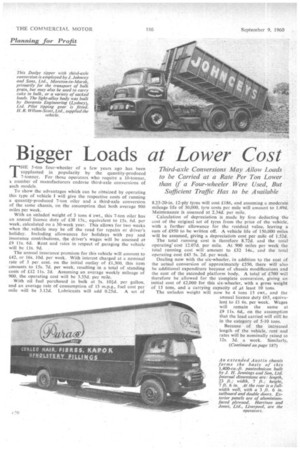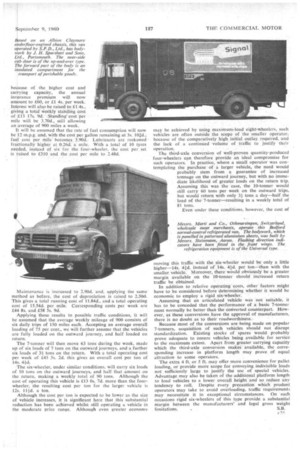Bigger Loads at Lower Cost
Page 98

Page 103

If you've noticed an error in this article please click here to report it so we can fix it.
Third-axle Conversions May Allow Loads to be Carried at a Rate Per Ton Lower than if a Four-wheeler Were Used, But Sufficient Traffic Has to be Available
THE 5-ton four-wheeler of a few years ago has been supplanted in popularity by the quantity-produced 7-tanner. For those operators who require a 1.0-tanner, a number of manufacturers endorse third-axle conversions of such models.
To show the advantages which can be obtained by operating this type of vehicle I will give the respective costs of running a quantity-produced 7-ton oiler and a third-axle conversion of the same chassis, on the assumption that both average 900 miles per week.
With an unladeri weight of 3 tons 4' cwt.. this 7-ton oiler has an annual licence duty of £38 I5s., equivalent to 15s. 6d. per week, calculated on a 50-week year. This allows for two weeks when the .vehicle may be off the road for repairs or driver's holiday. Including allowances for holidays with pay and insurance contributions, the driver's wages will be assessed at £9 I Is. 6d. Rent and rates in respect of garaging the vehicle will be 1 ls. 9d.
The annual insurance premium for this vehicle will amount to £42, or 16s. 10d. per week. With interest charged at a nominal rate of 3 per, cent. on the initial outlay of £1,300. this item amounts to 15s. 7d. per week, resulting in a total of standing costs of £12 1 ls. 2d. Assuming an average weekly mileage of 900. the operating cost will be 3.35d. per mile.
With oil fuel purchased in bulk at 3s. ind. per gallon, and an average rate of consumption of 15 m.p.g., fuel cost per mile will be 3.12d. Lubricants will add 0.25d.. A set of 8.25-20-in. 12-ply tyres will cost £186, and assuming a moderate mileage life of 30,000, tyre costs per mile will amount to 1.49d. Maintenance is assessed at 2.34d. per mile.
Calculation of depreciation is made by first deducting the cast of the original set of tyres from the price of the vehicle, with a further allowance for the residual value, leaving a sum of .1950 to be written off. A vehicle life of 150,000 miles will be assumed, giving a depreciation cost per mile of 1.52d.
The total running cost is therefore 8.72d. and the total operating' cost 12.07d. per mile. At 900 miles per week the total running cost willamount to £32 14s., and the total operating cost £45 5s. 2d, per week.
Dealing now with the six-wheeler, in addition to the cost of the actual conversion of approximately £550, there will also he additional expenditure because of chassis modifications and the cost of the extended platform body. A total of £700 will therefore be allowed for the complete conversion, giving an initial cost of £2,000 for this six-wheeler, with a gross weight of 15 tons, and a carrying capacity of at least 10 tons.
The unladen weight will now be 4 tons 13 cwt., and the annual licence duty £65, equivalent to £1 6s. per week. Wages will remain the same at £9 I Is. 6d,. on the assumption that the load carried will still be in the category of 5-10 tons.
Because of the increased length of the vehicle, rent and rates will be nominally raised to 12s. 3d. a week. Similarly,
(Continued on page 187)
because of the higher cost and carrying capacity, the annual ingurance premium will now amount to £60, or £1 4s. per week. Interest will also be raised to £1 4s.. giving a total Weekly standing cost of 113 17s. 9d. Standing cost per mile will be 3.70d., still allowing an average of 900 miles a week.
It will be assumed that the rate of fuel consumption will now be 12 m.p.g. and, with the cost per gallon remaining at 3s. 101d., fuel cost per mile becomes 3.90d. Lubricants are reckoned fractionally higher at 0.26d. a mile. With a total of 10 tyres needed, instead or six for the four-wheeler, the cost per set is raised to £310: and the cost per mile to 2.48d.
Maintenance is increased to 2.90d. and, applying the same method as before, the cost of depreciation is raised to 2.30d. This gives a total running cost of 11.84d., and a total operating cost of 15.54d. per mile. Corresponding costs per week are £44 8s. and £58 5s. 9d.
Applying these results to possible traffic conditions, it will be assumed that the average weekly mileage of 900 consists of six daily trips of 150 miles each. Accepting an average overall loading of 75 per cent., we will further assume that the vehicles are fully loaded on the outward journey, and half loaded on ret urn.
The 7-tonner will then move 63 tons during the week, made up of six loads of 7 tons on the outward journeys, and a further six loads of 31 tons on the return. With a total operating cost per week of £45 5s. 2d. this gives an overall cost per ton of 14s. 40.
The six-wheeler, under similar conditions, will carry six loads of 10 tons on the outward journeys, and half that amount on the return, making a weekly total of 90 tons. Although the cost of operating this vehicle is £13 Os. 7d. more than the fourwheeler, the resulting cost per ton for the larger vehicle is 12s. 111d, a ton.
Although the cost per ton is expected to be lower as the size of vehicle increases, it is significant here that this substantial reduction has been achieved whilst still operating a vehicle in the moderate price range. Although even greater economy may be achieved by using maximum-load eight-wheelers, such vehicles are often outside the scope of the smaller operator. because of the comparatively high initial outlay required, and the lack of a continued volume of traffic to justify their operation.
The third-axle conversion of well-proven quantity-produced four-wheelers can therefore provide an ideal compromise for such operators. In practice, where a small operator was contemplating the purchase of• a larger vehicle, the need would probably stem from a guarantee of increased tonnage on the outward journey, but with no immediate likelihood of greater loads on the return trip. Assuming this was the case, the 10-tonner would still carry 60 tons per week on the outward trips. but would return with only 31 tons a day—half the load of the7-tonner—rcsulting in a weekly total of 81 tons.
Even under these conditions, however, the cost of moving this traffic with the six-wheeler would be only a little higher--14s. 414.1. instead of 14s, 41d. per ton—than with the smaller vehicle. Moreover, there would obviously be a greater margin available on the 10-tonner should increased return traffic be obtained.
In addition to relative operating costs, other factors might have to be considered before determining whether it would he economic to employ a rigid six-wheeler.•
Assuming that an articulated vehicle was not suitable, it has to be conceded that the performance of a basic 7-tonner must normally be better than the converted counterpart. However, as these conversions have the approval of manufacturers, there is no doubt as to their roadworthiness.
Because most of the conversions are being made on -popular 7-tonners, acquisition of such vehicles should not disrupt standardization. Existing stocks of spares would probably prove adequate to ensure vehicles being available for service to the maximum extent. Apart from greater carrying capacity which the third-axle conversion makes available, the corresponding increase in platform length may prove of equal attraction to some operators.
The extra 4 ft. or 5 ft. may offer more convenience for pallet loading, or provide more scope for conveying indivisible loads not sufficiently large to justify the use of special vehicles. Advantage may also be taken of the additional platform length to load vehicles to a lower overall height and so reduce any tendency to roll. Despite every precaution which prudent operators may take to avoid overloading, traffic requirement; may necessitate it in exceptional circumstances. On such occasions rigid six-wheelers of this type provide a substantial margin between the manufacturers' and legal gross weight limitations. S.B.




















































































































































